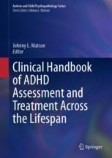Search
Search Results
-
Validation of a Measurement Model to Identify Socio-emotional Difficulties in Preschool Children: The Preschool Pediatric Symptom Checklist—Chilean Version
Identifying issues in early childhood enables timely interventions, potentially mitigating future mental health risks. In this context, this study...

-
Neuropsychological Assessment of Apraxia: Where Network Reality and Domain Assessment Collide
Neuropsychological assessment is based on the premise that neuropsychological functioning in humans is based on the operation and integration of...
-
Gender differences in symptom presentation and treatment outcome in children and youths with eating disorders
BackgroundTo address the gaps in the literature examining eating disorders among males and gender minority youths, a prospective study was designed...
-
Validity of the Toddler Autism Symptom Inventory in Non-Hispanic White and Black Toddlers
Racial disparities exist in autism diagnosis, and yet, the development of most diagnostic tools has not explicitly examined measurement equity...

-
Symptom Dimension Breakpoints for the Obsessive-Compulsive Inventory-Child Version (OCI-CV)
Pediatric obsessive-compulsive disorder (OCD) clusters around three major symptom dimensions: contamination/cleaning, symmetry/ordering, and...

-
State and Trait Risk and Resilience Factors Associated with COVID-19 Impact and Obsessive–Compulsive Symptom Trajectories
The COVID-19 pandemic may exacerbate common symptoms of obsessive–compulsive disorder, such as fears of contamination or causing harm to others. To...
-
Use of the Word Memory Test (WMT), Medical Symptom Validity Test (MSVT) and Nonverbal Medical Symptom Validity Test (NV-MSVT) in Assessment Following Head Injury
The current chapter reviews, in detail, the Word Memory Test (WMT), with a focus on its forensic applications, especially as related to litigation...
-
Exploring the link between maternal symptom constellations and offspring’s psychopathological risk: insights from the p factor model
Background: Recent research has introduced the concept of a unifying dimension, known as the “p factor,“ which encompasses various comorbid disorders...
-
Associations Among Autism Symptom Domains and Facets of Caregiver Strain
Parents of children with autism spectrum disorder (ASD) often experience elevated levels of caregiver strain (CGS). Few studies have examined the...

-
Stability of Sluggish Cognitive Tempo Compared to Externalizing and Internalizing Parent Symptom Ratings from Age 9 to 8-Years Follow-up in a Population-Based Sample
Little is known about the prevalence and stability of sluggish cognitive tempo (SCT) compared to other symptom clusters. Parent SCT ratings at...
-
Trajectories of Symptom Change in School-Based Prevention Programs for Adolescent Girls with Subclinical Depression
Effectiveness research on depression prevention usually compares pre- to post-intervention outcomes across groups, but this aggregation across...

-
Parents’ and Teachers’ Perspectives of Autism and Co-Morbidity Symptom Severity in Young Children with ASD Over One School Year
PurposeOnly a few studies examined the longitudinal pattern of parent–teacher reports on autism severity and comorbidities in autism spectrum...

-
Examining Base Rates of Symptom Endorsement and the Roles of Sex and Depressive Symptoms on the Structured Inventory of Malingered Symptomology (SIMS) in a Non-clinical Population
Symptom validity tests (SVTs) assist in ensuring that our diagnostic conclusions are grounded in credible psychometric results. The Structured...
-
Trajectory of Change in Parental Accommodation and Its Relation to Symptom Severity and Impairment in Pediatric OCD
Family accommodation (FA) has been shown to relate to poorer treatment outcomes in pediatric obsessive compulsive disorder (OCD), yet few studies...

-
Assessment of Attention-Deficit/Hyperactivity Disorder in Children and Adolescents
Many empirically validated tools and measures have been created for us in attention-deficit/hyperactivity disorder (ADHD) assessment in child and...
-
Assessment of Anxiety Disorders in Children and Adolescents
Much has been done in the improvement for the evidence base of child assessment over the past several decades. In particular, the rise of...
-
Differential Diagnosis and Assessment of Comorbid Disorders in Children and Adolescents
This chapter explores disruptive mood dysregulation disorder (DMDD) in children, characterized by pervasive irritability and difficulty in managing...
-
Assessment of Autism Spectrum Disorders
The prevalence of Autism Spectrum Disorder (ASD) has been increasing at substantial rates since the Centers for Disease Control and Prevention began...
-
Genotype-Environment Interaction in ADHD: Genetic Predisposition Determines the Extent to Which Environmental Influences Explain Variability in the Symptom Dimensions Hyperactivity and Inattention
Although earlier research has shown that individual differences on the spectrum of attention deficit hyperactivity disorder (ADHD) are highly...

-
A multi-site German validation of the Interoceptive Accuracy Scale and its relation to psychopathological symptom burden
Altered interoception is thought to be implicated in the development of psychopathology. Recent proposals highlight the need to differentiate between...

